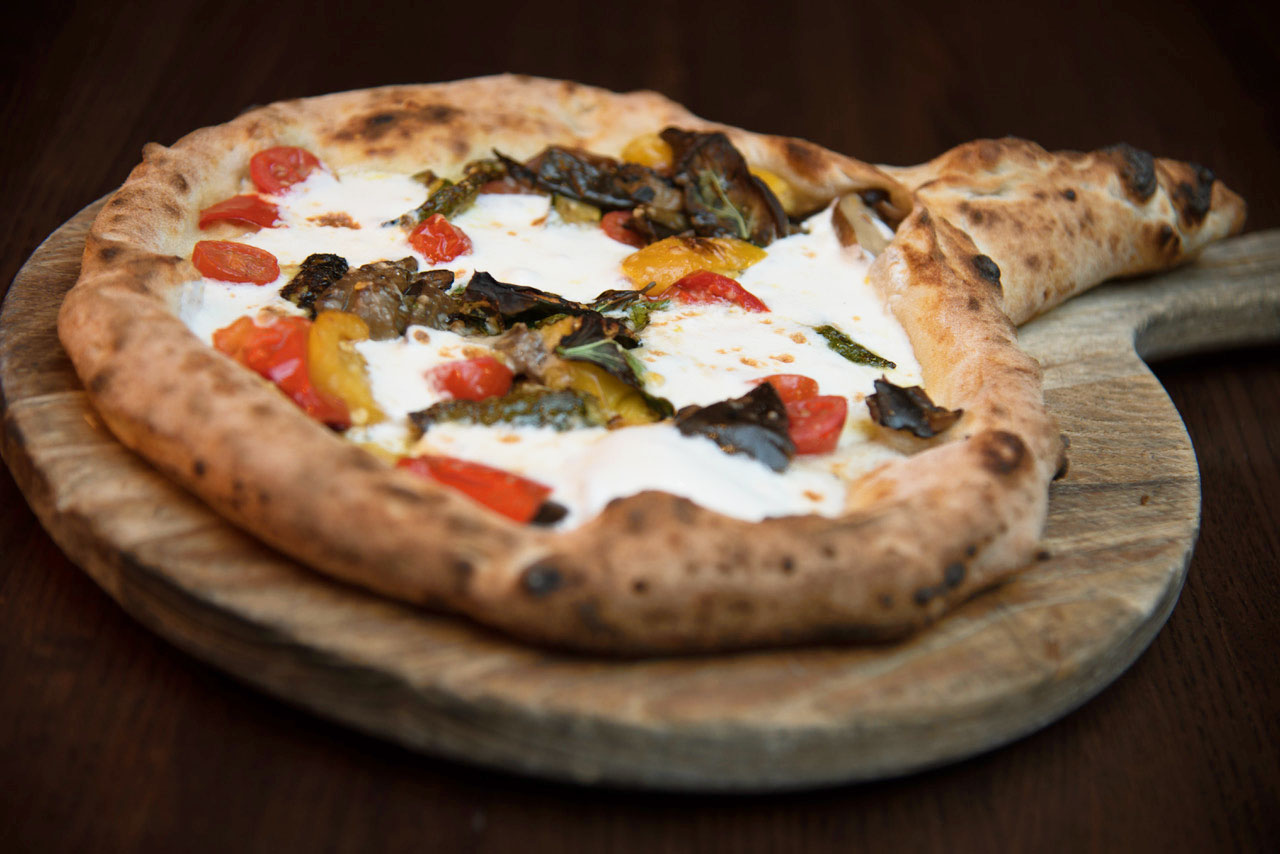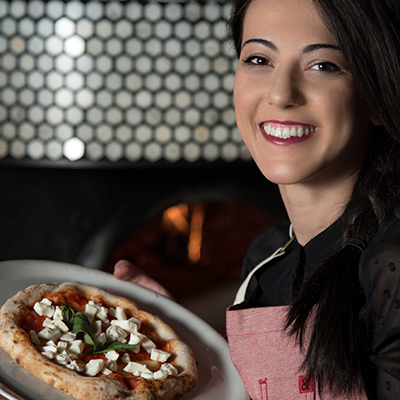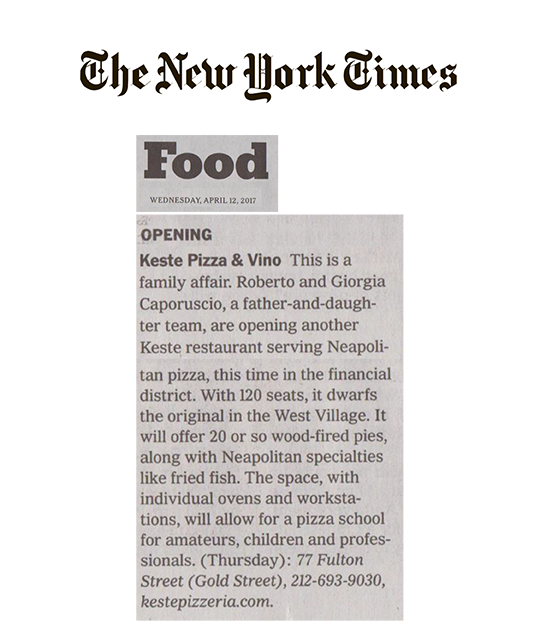“Keste Might be Some Of the Best Pizza I’ve Ever Had. Seriously.”

“(…) A classic dish to try is their creamy Burrata with prosciutto di Parma. Load a slice of Burrata with the prosciutto onto a warm piece of bread and drizzle it with some fresh olive oil. You will be transfixed with just how fresh and tasty all three components are, and will leave you satisfied and ready for what’s to come.”
I am someone who has had their fare share of pizza in my lifetime, and generally love each slice that I “gavone” each time I have it. Keste Pizzeria, which is located on Gold Street in the heart of the financial district, just might be some of the best pizza I have ever had here in Manhattan. And given that this is one of the cities where pizza runs supreme, it can truthfully mean a lot to stand at the front of the pack for this sort of culinary treat.
(To read the full article, click here)
Copyright by Ryan Shea from Manhattan Digest
- Published in press
Making and eating Neapolitan pies at Kesté Pizza

“With a pizza shop on every corner in New York, what makes pizza from Naples unique? Just about everything, Roberto and Giorgia say, from the ingredients to the pizza maker and the culture of eating.”
NEW YORK (FOX 5 NEWS) – Pizza is a family affair for Roberto Caporuscio and daughter Giorgia Caporuscio. Roberto is a pizzaiolo, Italian for master pizza maker. Giorgia is a pizzaiola, a female master pizza maker — one of the few in the United States.
Together, they run Kesté Pizza, a place where you can order a delicious pie or learn how to make one yourself. Kesté Pizza and Vino is a pizza shop and school.
(To read the full article, click here)
Copyright by Alison Morris, Christal Young from FOX 5 NY
- Published in press
How to make pizza as Neapolitan pro
 How to make a better pie, according to pizza princess Giorgia Caporuscio:
How to make a better pie, according to pizza princess Giorgia Caporuscio:
1. Go easy on the tomato sauce. “Too much will make the pizza soggy. Just spoon on a thin layer.”
2. “Many home ovens do not get hot enough. Preheat the oven, full blast, for an hour. Then push your pizza all the way to the back, where the oven is hottest.”
3. “Prior to making your pizza, massage the dough. That way you push air from the center to the outside, and you end up with a crisper crust.”
(To read the full article, click here)
By Michael Kaplan
New York Post
- Published in press
How to make pizza as Neapolitan Pro
Good slices of New York pizza are as ubiquitous as manhole covers. Great slices are rare. Making superior pizza at home — well, if you live in my home, it’s a bit of a crapshoot.
Standard operating procedure on homemade-pizza night is to pick up the dough from Park Slope slice joint Smiling Pizza, get fresh mozzarella plus sauce from Italian grocer Russo’s and pull the thing together with a bit of dry pizza seasoning sprinkled on top.
But it never quite comes out as well as I hope.
So when I hear that rural-Italy native and Neapolitan-pizza expert Roberto Caporuscio and his daughter Giorgia, the pie geniuses behind the acclaimed West Village pizzeria Kesté, are offering pizza-making classes at their new outpost in the Financial District, I sign up.
In a wood-raftered back room of the shop, I join the other students.
Roberto brings us up to speed on the history of pizza — it dates back to the 1600s, he says, a time when Neapolitans feared that tomatoes were poisonous and ate sauce-free pies; the first pizza spot in Naples opened in 1786.
First, we learn to make the dough: tap water, a pinch of fresh yeast, flour and salt.
Kneading the dough by hand — a 15-minute process that the Caporuscios find to be relaxing — Roberto offers a good justification for scratch pizza: “Late at night, you can easily wind up with a slice made from dough that has extra yeast in it, so that it can rise quicker,” he says, pointing out that the extra-yeast tactic is employed by places needing to do quick turnarounds on dough because they run low as closing-time nears. “[The] next morning, you feel [that extra yeast] in your stomach.”
Modal Trigger
The author with his pizza.Stefano Giovannini
Kesté lets its little pillows of dough rise for times that range from 20 hours to two days. Pre-made dough, according to Giorgia, is likely to spend around eight hours maturing, which leads to heavier, denser pizza. But since this is just a three-hour course, Roberto hoists a plastic container lined with risen dough.
We begin to gently massage the soft and sticky stuff in order to push air from the center to the edge. This ensures a thick crust.
Eschewing the showiness of American pizza makers who like tossing their dough in the air, Roberto prefers gently forming it into a small circle via softly pressing down and stretching it out on the table with some flour underneath to prevent sticking.
Ever an Italian, he likens pizza dough to a wife: Press too hard and you won’t have dinner.
Next, a light flourish of tomato sauce. The Caporuscios use canned tomatoes from Italy, with just a little salt but no sugar or garlic.
We add a sprinkling of grated pecorino, a few fresh basil leaves, ground sausage cooked in red wine and a generous spread of Buffalo mozzarella. But, Giorgia warns, don’t be too generous, lest pies get weighed down to the point of collapse.
I finish with a drizzle of olive oil. Giorgia slides my pie onto a pizza peel, shoves it into the oven and allows two minutes of cooking at 900 degrees.
In no time at all, I am chowing down on a perfect pie, sipping red wine and looking forward to my family’s next homemade pizza night.
Pizza-making classes ($80) are held on Saturdays from 2 to 5 p.m. Kesté Wall Street, 77 Fulton St.
How to make a better pie, according to pizza princess Giorgia Caporuscio
1. Go easy on the tomato sauce. “Too much will make the pizza soggy. Just spoon on a thin layer.”
2. “Many home ovens do not get hot enough. Preheat the oven, full blast, for an hour. Then push your pizza all the way to the back, where the oven is hottest.”
3. “Prior to making your pizza, massage the dough. That way you push air from the center to the outside, and you end up with a crisper crust.”
By Michael Kaplan
New York Post
- Published in press
The Absolute Best Gluten-Free Dining Options in New York
There are two types of “gluten-free” restaurants: Those that set up shop with an unambiguous, anti-gluten mission statement, effectively flying a “No Wheat Welcome Here” flag right out front; and places that serve baguettes or couscous, but also cater to diners with sensitivities by offering a portion of their menu scrubbed of gluten. For celiacs and those with severe (or even life-threatening) allergies, the delineation is crucial. The good news is that menus are always evolving, and high- and low-brow options abound for just about everyone. Here are the best.
The Absolute Best
1. Del Posto
85 Tenth Ave., nr. 16th St.; 212-497-8090
An uptick in special diet requests led Mark Ladner, Del Posto’s former executive chef, to develop the restaurant’s superlative gluten-free program. Ladner left this year, but Melissa Rodriguez capably channels her own point of view into the menu, which is good news because, invariably, celiacs say pasta is their most-missed food. Here, the Cup4Cup-based pastas are heartening and delightfully al dente. Orecchiette is nicely thick and dimpled, coated with sticky meat jus in a rustic dish of charred lamb-neck sausage; ribbons of no-gluten pasta swirled under a cap of Pecorino frico have better-textured spring than their wheaty analog, and diners can truffle it up with plump parcels of bauletti stuffed with sheep’s-milk ricotta as a supplement. While dairy is present in some options — like the revelatory focaccia with an orb of crème fraîche — servers are quick to navigate deftly around any celiac-associated lactose intolerance. There’s even a deluxe multicourse option for gluten-free vegetarians. If the options make the opulence worthwhile, all the freebies — from the amuse-bouche-like “assaggi” at the beginning, to the edible rice-paper-wrapped caramels and “sour patch” cantaloupe segments at the end — also make a meal here a lot of fun.
2. Inday
1133 Broadway, entrance on 26th St.; 917-521-5012
The Californian-vibed and “Indian-inspired” fast-casual spot tends to get lost in what could be called the Kale Triangle of salad places, like the Little Beet and Sweetgreen in central NoMad. The nearly two-year-old proto-chain is less hyped than those (admirable) spots, but its vegetable-intensive bowls are worth following. Goofy names aside (Cauli-fornia, Sas-Squash), they come loaded with stuff like tangy carrots, mild coconut chutney, masala chickpeas, heirloom carrots roasted with vadouvan, and an unwieldy but flavorful paste called charcoal eggplant. Add-on proteins include salmon with a sour tamarind veneer, and nice, beefy short ribs. A ranchlike yogurt sauce can be ladled over bowls, and the serrano-based house hot sauce has a decent kick. Pappads, rebranded here as “lentil crisps,” top each large-portioned bowl. Tall bottles of cold brew (supplied by Jack’s), with coconut cream and cardamom, are compelling enough that you may be prompted to experiment with making your own at home.
3. Senza Gluten
206 Sullivan St., nr. Bleecker St.; 212-475-7775
Senza Gluten bills itself as the “first completely gluten-free Italian restaurant in Greenwich Village,” which may be true. When it’s firing on all cylinders, the dining room might as well be a trattoria in a parallel universe where wheat flour never existed. Discs of buffalo mozzarella are finessed with prosciutto and arugula on nicely browned flatbreads, while penne pomodoro and thick lasagna noodles layered with Bolognese serve up none of the lifelessly grainy or mushy attributes that can befall alternative pastas elsewhere. Lunch-hour sandwiches come on baguettelike bread that has an appealingly decent briochelike crumb, and even the truffled egg-in-a-hole brunch dish, served in a risk-takingly stout wedge of no-gluten white bread, impresses with soft texture and toasty crust.
4. The Little Beet Table
333 Park Ave. S., nr. 25th St.; 212-466-3330
The menu here is in fact centered on a mission statement for diners that, among other things, means everything on the menu — from the Ipswich Saison to bowls of soup and cavatelli — is gluten-free. The slightly more formal offshoot of the fast-casual Little Beet, this spot changes its menu often, and the best dishes are entrées like strip steak or roasted branzino (the picks that happen to most closely resemble solid bistro food, in other words), while desserts like the ice-cream sundae with salted chocolate cookies stand out.
5. Friedman’s
Multiple locations
The prevailing greasy spoon–esque ethos here means that blueberry pancakes can be ordered gluten-free, along with chicken and waffles that work around the flour dredge and batter. Pastrami on rye is a particularly compelling choice for gluten-adverse diners, as it hews to peppery classic-delicatessen specs. In fact, the majority of the mini-chain’s all-day offerings steer clear of gluten by design. Attentive servers are knowledgeable about all of the ingredients involved, and can also guide customers through a gamut of potential allergens or any other restrictions.
Honorable Mentions
Guadalupe Inn
1 Knickerbocker Ave., at Johnson Ave., Brooklyn; 718-366-0500
At Ivan Garcia’s handsome Bushwick restaurant, the citrus-soaked charred-cauliflower “ceviche” comes in one of those broad-rimmed white bowls with a small dip in the middle, and large-format dishes like trompito for two are nothing if not ambitious. The restaurant is still finding its footing, but the entire menu, from the fried-cod tacos to the churros with cajeta, is prepared without gluten.
Hometown Bar-B-Que
454 Van Brunt St., at Reed St., Brooklyn; 347-294-4644
As the essential ingredients tend to be salt, pepper, meat, and smoke, barbecue parlors can be great havens for diners who cannot consume gluten. It’s best to pick one where the ribs are smoked every morning and the pork is pulled around the clock. New York’s preeminent smoked-brisket establishment fits that bill mightily, with caveats: Regular bread is the vehicle for Hometown’s sandwiches; there’s no getting around the wheat in the queso macaroni and cheese; and soy figures into the sauces. But pit beans simmered with burnt ends and juicy, porky collards are among the cross section of sides that can be ordered with abandon. Plus, the wonderfully dark and oaky bark on the brisket does not need one iota of sauce.
Kesté
Multiple locations
The love that an untold number of New Yorkers have for Roberto Caporuscio’s pizzeria seems to knows no bounds, and it may come as no surprise that its long-running gluten-free menu has a near-fanatical following of its own. The pies don’t always achieve the same oven-blistered puffy heights as their standard issue Neapolitan counterparts, but that’s a tall order, and the wealth of top-notch toppings, like cool buffalo mozzarella, more than make up for the underinflation.
Oca
250 Mott St., nr. Prince St.; 212-966-0622
The term tapiocaria may at first not inspire much consumer confidence, but consider that 800 million people bank on powdered cassava root (a.k.a. yuca or manioc) as a food staple. Crêpes made from the stuff also happen to be delicious, organic, and gluten-free. This tiny Brazilian café provides specific cal counts and nutritional info with its adorable, wispy namesake “ocas.” Savory and sweet options abound, but versions that do a little of both (grilled pineapple and Feta with pepper and mint, for example) astound the most.
Rubirosa
235 Mulberry St., nr. Prince St.; 212-965-0500
Flashes of some of New York’s enduring red-sauce joints were baked right into Rubirosa, and these days the seven-year-old restaurant has the ineluctable feel of an old-school Little Italy pizzeria. There’s no discernible difference between gluten-free chicken parm and decent bread-crumbed versions doled out in the immediate neighborhood, and the fried calamari is likewise as crisp and oil-free as floured versions, delivered hot to the table trailing the pleasant aroma of a freshly baked cake. As for pizza, the gluten-free “classic” has a rice-cracker-like crispness and mellow sweetness of corn. The crust is thin, with the same cheese and sauce application as the regular pies, and one that can be traced directly to the venerable Joe & Pat’s of Castleton Corners, Staten Island, at that. It’s just about as classic as it can get.
Springbone Kitchen
90 W. 3rd St., nr. Sullivan St.; 646-368-9192
What at first seems like a handsome storefront containing a monsoon of generally overblown food trends — butter coffee, turmeric bone broth, spiralized zucchini — quickly settles into something more accessible once the menu is deciphered. Coffee is from La Colombe, and collaborations like the recent “Paleo hot chocolate” with Red Hook’s Raaka Chocolate keep things interesting. When add-on guac and an optional egg are skipped, the caramelized-onion burger on a gluten-free bun admirably approaches classic luncheonette standards.
White Maize
277 Smith St., nr. Sackett St., Brooklyn; 347-946-2493
Arepas like the ones found here and at (the unrelated, but also great) Caracas are griddle-crisp on the outside and steamy within, and because the master recipe calls for a certain kind of precooked corn flour, there’s no need for wheat. Pulled beef and cheese, chicken dressed with avocado salad, and wonderfully melty bean-and-cheese arepas lead the pack. Tequeños, which are a bit like Venezuelan mozz sticks, contain wheat, but just about everything else excludes gluten.
By Hugh Merwin
Grup Street
- Published in press
Pizza Restaurant and Cooking School Kestè Pizza & Vino Opens in FiDi
Pizza master Roberto Caporuscio and his daughter Giorgia Caporuscio have opened their fourth restaurant, Kestè Pizza & Vino. The design of the 150-seat pizzeria, located in the Financial District, is inspired by a rare copy of the 1866 book “Usi e Costumi di Napoli,” which gave clues to how pizzerias were designed in the late 19th century. As a result, Kestè features aged wood tables, ceramics from the Amalfi coast, and copper pizza ovens. Kestè means “this is it” in the Neapolitan dialect.
Seventy pizzas—all original creations by Roberto Caporuscio—include seven types of fried pizzas, 18 types of gluten-free pizzas, and 20 seasonal pizzas that reflect Italy’s regional cuisines. The classic Pizza Margherita is made with all-organic flour, cheese, and tomatoes.
There is a pizza school on site that teaches pizza-making to both professionals and amateurs. Roberto Caporuscio is the U.S. president of the Association of Neapolitan Pizza Makers, the Italian governing body that teaches Neapolitan pizza-making.
Open daily for lunch and dinner.
Kestè Pizza & Vino
77 Fulton St. (near Gold Street)
Financial District
212-693-9030
KestePizzeria.com
By Channaly Philipp
- Published in press
Kesté, the Art of making authentic Neapolitan pizza, lands at Wall Street
100% “Designed and Made in Italy”: World renowned Maestro Roberto Caporuscio opens his fourth location at 77 Fulton Street in New York City.
Kesté Wall Street is more than a restaurant, is more than the usual “pizzeria”. It’s the place where, without travelling far, you will experience the flavors, the taste and the touch of the ancient authentic tradition of the art of Neapolitan pizza making.
You leave behind the Financial District and you enter an ancient Neapolitan Pizzeria with contemporary features and technologies.
It’s the first time that you can watch LIVE streaming your own pizza being made even when you order it from home or office.
The “total concept”, starting from the vision and the idea to the digital signage system that links the forth different Kesté locations and LIVE streaming power by CSS Communication is a 100% “Designed and Made in Italy”. It’s the first time that this new concept of Italian experience lands in the US and New York City is the most natural place to start.
Father and daughter pizzaioli Roberto and Giorgia Caporuscio have brought their acclaimed pizza making skills to Manhattan’s Financial District (FiDi) with the opening of the newest family-owned location of Kesté Pizza & Vino at 77 Fulton Street. The expansive space, with windowed doors onto the street, has 150 seats, and is decorated with aged woods, Amalfi coast ceramics, “Lecce stones,” and copper, to emulate the style of the 1800’s, remembering the old authentic Neapolitan Pizzeria. The inspiration behind the restaurant’s design came from a rare copy of the book “Usi E Costumi di Napoli e Contorni” written by Francesco de Bourcard published in 1866, including details on how pizzerias were structured and decorated at the time.
Kesté Pizza & Vino offers over 70 types of Neapolitan pizzas, all original creations by Mastro Pizzaiuolo Roberto Caporuscio, signifying his knowledge of the history, the authentic tradition and the evolution of Neapolitan pizza. In his unique offering, Mastro Caporuscio also added 7 different types of fried pizza, 18 types of gluten free pizzas or the most famous Pizza Margherita made with all organic ingredients including flour, cheese and sauce, and 20 seasonal pizzas rappresenting the different regionality of Italy’s cuisines. The attention to the ingredients, the selection of high quality Italian products, the wine collection made up of a top selection of high quality Italian wines complete the Kesté experience.
The daily menu will be overseen by Mastro Caporuscio’s daughter Giorgia, one of the few – if not the only – young female pizzaiolas in the United States. Both father and daughter are the recipients of countless awards, and critical acclaim for their pizza making skills.
The many accolades for Kesté include “#1 Pizza in New York” by New York Magazine, “Best Pizza” in the State of NY by Food Network Magazine, amongst the top 25 “Best Pizza Places in the US” by Food and Wine Magazine and 5 of “The Most Authentic Pizzas Outside Italy” (the only one in the US) by Mr Porter.
Maestro Caporuscio’s love, passion and dedication for the preservation of the authentic Neapolitan pizza is evidenced by the his foresights in establishing of the Pizza Academy Foundation.
The goals of Pizza Academy Foundation (PAF) is to preserve, represent, share and maintain the tradition, culture and quality of Neapolitan pizza making skills in the world.
The on-premise cooking school where Mastro Caporuscio and his daughter Giorgia, will conduct courses in the art of pizza and mozzarella making skills. Having taught the art of pizza to many chefs over the years, they have seen the desire for more people, both professional and amateur, to learn the art of pizza making. With its individual cooking stations, featuring six pizza ovens, they have the opportunity to hold hand’s-on classes for adults, children, and host private events (up to 40 people) bringing a unique meaning to the phrase “pizza party”.
Maestro Caporuscio, who serves as U.S. President of the Associazione Pizzaiuoli Napoletani (APN – Association of Neapolitan Pizza Makers), the elite Italian governing body that safeguards the 300-years-old tradition art of Neapolitan pizza making. Kesté is the official location of the U.S. chapter of the APN and a certificate is given to those who complete the professional course.

- Published in press
Regina Margherita pizza
- Published in press
Best Pizza Places In The U.S.
- Published in press
THE CITY’S TOP TWENTY PIES OF THE MOMENT…
At the risk of being run out of town by an angry, pizza-peel-wielding mob, we have to concede Read more
- Published in press






